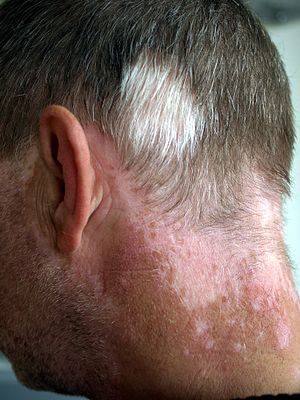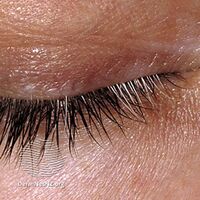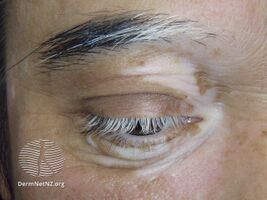Poliosis
| Poliosis | |
|---|---|
 | |
| Depigmentation of sections of skin and hair in 48-year-old man with vitiligo and poliosis. | |
Poliosis, also called poliosis circumscripta, is the decrease or absence of melanin (or colour) in head hair, eyebrows, eyelashes or any other hairy area. It is popularly known as white forelock when it affects hair directly above the forehead.
This condition can cause single or, less commonly, multiple white patches on the hair. Some mistake these white patches for simple birth marks. In poliosis there is decreased or absent melanin in the hair bulbs of affected hair follicles; the melanocytes of the skin are usually not affected.[1]
Associated medical conditions
Poliosis occurs in several genetic syndromes such as piebaldism, Waardenburg syndrome, neurofibromatosis type I, and tuberous sclerosis.[2] It can also occur in conditions such as vitiligo, Vogt–Koyanagi–Harada disease, alopecia areata, sarcoidosis, and in association with neoplasms and some medications.[1]
Popular culture
It is sometimes called a Mallen streak, after a fictional family with hereditary poliosis. Catherine Cookson wrote a novel and later a TV series called The Mallen Streak, where a family had the condition. Sports presenter Dickie Davies, runner Sam Brown, punk singer Dave Vanian and fashion expert Stacy London are also known for their Mallen streaks. During his tenure as the host of Talk Soup, host John Henson repeatedly referred to his own poliosis as a "skunk spot."
Additional images
-
Poliosis
-
Poliosis
References
- ↑ 1.0 1.1 Sleiman R, Kurban M, Succaria F, Abbas O (2013). "Poliosis circumscripta: overview and underlying causes". J Am Acad Dermatol. 69 (4): 625–33. doi:10.1016/j.jaad.2013.05.022. PMID 23850259.}
- ↑ Willacy H. (2010). "Tuberous Sclerosis". PatientPlus. Patient.info. Archived from the original on July 5, 2015. Retrieved May 2, 2011.
External links
| Classification |
|---|

